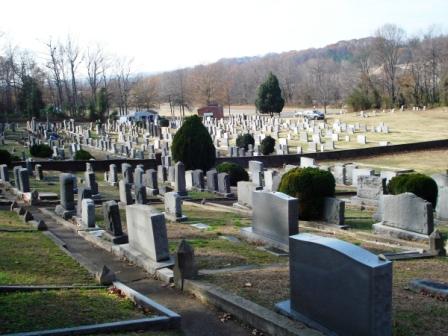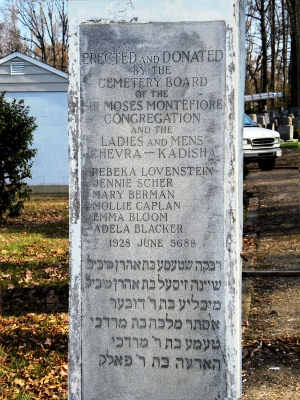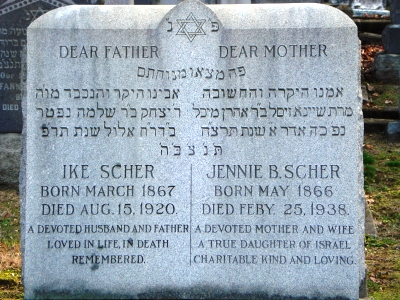Sir Moses Montefiore Cemetery
Although Richmond 's Jewish community was already firmly established by the end of the nineteenth century, recently immigrated Russian Jews found that they desired a more traditional style of worship compared to Richmond 's other Jewish congregations. This led to a small group of Russian immigrants founding the Sir Moses Montefiore Congregation in 1886. Named for a greatly admired Jewish philanthropist from Great Britain , the Jews that made up the Sir Moses Montefiore Congregation had originally been members of Kenesseth Israel , a Polish congregation that would later reunite with the Sir Moses congregation in 1952. By 1891, the new Sir Moses Montefiore congregation was able to purchase a synagogue owned by Beth Shalom on Mayo Street for $3000. Now physically established in Richmond , the congregation flourished and was able to acquire cemetery land close to Kenesseth Israel 's Oakwood Hebrew Cemetery in the far East End in 1905.
 The same growth that allowed the Sir Moses congregation to purchase land for the Sir Moses Montefiore Cemetery also required it to move to a larger synagogue. Also in 1905, the congregation moved to more spacious surroundings by purchasing the Eleventh Street Shul from Beth Ahabah. This move attracted even more Eastern European Jews living in Richmond 's Church Hill, helping the Sir Moses congregation to continue to thrive. In 1948, the smaller orthodox Etz Chaim congregation was absorbed into Sir Moses. This prompted yet another move, this time to the West End , as well as a new name for the congregation: Beth Israel. Four years later, Beth Israel merged with Kenesseth Israel , the congregation that members of Sir Moses Montefiore had originally separated from, to form Kenesseth Beth Israel. By this time, Kensseth Israel 's spacious Oakwood Hebrew Cemetery had been transferred to an independent board. This led to the new Kenesseth Beth Israel congregation choosing to continue using the smaller Sir Moses Montefiore Cemetery , which would retain its original name.
The same growth that allowed the Sir Moses congregation to purchase land for the Sir Moses Montefiore Cemetery also required it to move to a larger synagogue. Also in 1905, the congregation moved to more spacious surroundings by purchasing the Eleventh Street Shul from Beth Ahabah. This move attracted even more Eastern European Jews living in Richmond 's Church Hill, helping the Sir Moses congregation to continue to thrive. In 1948, the smaller orthodox Etz Chaim congregation was absorbed into Sir Moses. This prompted yet another move, this time to the West End , as well as a new name for the congregation: Beth Israel. Four years later, Beth Israel merged with Kenesseth Israel , the congregation that members of Sir Moses Montefiore had originally separated from, to form Kenesseth Beth Israel. By this time, Kensseth Israel 's spacious Oakwood Hebrew Cemetery had been transferred to an independent board. This led to the new Kenesseth Beth Israel congregation choosing to continue using the smaller Sir Moses Montefiore Cemetery , which would retain its original name.
 The cemetery's location is particularly worth noting as it is highly significant to Richmond 's Jewish heritage. Directly to the right of the Sir Moses Montefiore Cemetery is the much smaller Workmen's Circle Cemetery . This cemetery was founded soon after Sir Moses in 1907 by the Workman's Circle, at the time a Jewish fraternal/mutual aid society based on socialistic principles. Jennie Scher Road , the street on which the Sir Moses Montefiore Cemetery is located, is named after Jennie Scher, a Russian immigrant who was one of the founding members of the Sir Moses congregation and an important Richmond philanthropist. Although the road originally directly connected the Oakwood Hebrew Cemetery and the Sir Moses Montefiore Cemetery , this is no longer the case as sections of the road have been renamed. Along with her husband, Isaac, Jennie Scher is also buried in the Sir Moses Montefiore Cemetery .
The cemetery's location is particularly worth noting as it is highly significant to Richmond 's Jewish heritage. Directly to the right of the Sir Moses Montefiore Cemetery is the much smaller Workmen's Circle Cemetery . This cemetery was founded soon after Sir Moses in 1907 by the Workman's Circle, at the time a Jewish fraternal/mutual aid society based on socialistic principles. Jennie Scher Road , the street on which the Sir Moses Montefiore Cemetery is located, is named after Jennie Scher, a Russian immigrant who was one of the founding members of the Sir Moses congregation and an important Richmond philanthropist. Although the road originally directly connected the Oakwood Hebrew Cemetery and the Sir Moses Montefiore Cemetery , this is no longer the case as sections of the road have been renamed. Along with her husband, Isaac, Jennie Scher is also buried in the Sir Moses Montefiore Cemetery .
Today, the Sir Moses Montefiore Cemetery is still used by Kenesseth Beth Israel, which is now located on Patterson Avenue The entrance gate to the Sir Moses Montefiore Cemetery perhaps belies its current use. Likely due to vandalism rather than neglect, the deteriorated entrance does not reflect the care still given to the cemetery. Attesting to the modern significance of the Sir Moses Montefiore Cemetery are the small stones left on top of many of the cemetery's headstones, a sight unique to Jewish cemeteries. This is part of the traditional Jewish custom of placing stones on headstones when visiting a grave to signify a visit. Thus, although it may be one of Richmond 's lesser-known cemeteries, the Sir Moses Montefiore Cemetery continues to be used in its original tradition.
 Sir Moses Montefiore Cemetery
Sir Moses Montefiore Cemetery
Jennie Scher Road at Stony Run Parkway
Richmond , VA 23231
Sources:
Berman, Myron. Richmond 's Jewry, 1769-1976 . Charlottesville , VA : The University Press of Virginia , 1979.
Kenesseth Beth Israel Website
Shepherd, Samuel C. Avenues of Faith: Shaping the Urban Religious Culture of Richmond , Virginia , 1900-1929 . Tuscaloosa , AL : The University of Alabama Press, 2001.
Profile prepared by Erica Johnson
November, 2007